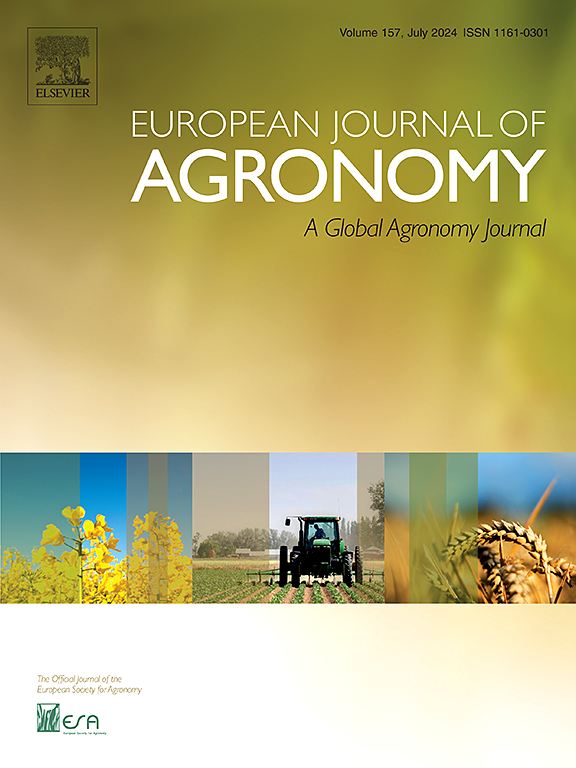橄榄园杂草综合管理:自然覆盖作物对杂草群落、橄榄产量和土壤肥力的影响
IF 4.5
1区 农林科学
Q1 AGRONOMY
引用次数: 0
摘要
橄榄林对地中海盆地的经济、农业生态和文化至关重要。有效的杂草管理对它们的长期可持续性和生产力至关重要。本研究评估了草地覆盖作物对杂草群落结构、橄榄产量和土壤肥力的影响,并将其与传统耕作方式进行了比较。三年多来,在西班牙南部测试了两种管理策略:草被作物(GCC)系统-结合免耕与化学控制,修剪行内空间的木材残留物,以及行间空间的自然草被作物和耕作(TL)系统,包括耕作操作和修剪行内和行间空间的木材残留物。通过两个时间点的丰富度、丰度、多样性(Shannon指数)和公平性(Pielou均匀度指数),以及橄榄产量、质量和土壤肥力的评估,评估了杂草群落和橄榄作物的影响。施用除草剂前,与TL相比,GCC系统行内和行间的杂草丰富度、丰度和多样性更高;施用除草剂后,GCC系统的丰富度和丰度仍然较高,行间多样性增加,杂草生物量保持在较低水平。橄榄树产量和品质未受影响,但土壤肥力在GCC处理下得到改善。这些结果表明,整合土壤覆盖方法,如自发草覆盖作物,可以平衡作物生产力和有益杂草多样性,促进可持续农业系统。本文章由计算机程序翻译,如有差异,请以英文原文为准。
Integrated weed management in olive orchard: The effect of spontaneous grass cover crops on weed community, olive production and soil fertility
Olive groves are vital to the Mediterranean Basin's economy, agro-ecology, and culture. Effective weed management is critical for their long-term sustainability and productivity. This study evaluated the effects of spontaneous grass cover crops on weed community structure, olive production, and soil fertility, comparing them with conventional tillage practices. Over three years in southern Spain, two management strategies were tested: a Grass Cover Crop (GCC) system—combining no-tillage with chemical control, pruning wood residues in intra-row spaces, and spontaneous grass cover crops in inter-row spaces and a Tillage (TL) system, which included tillage operations and pruning wood residues in both intra- and inter-row spaces. Weed community and olive crop impacts were assessed by examining richness, abundance, diversity (Shannon index), and equity (Pielou evenness index) at two time points, alongside evaluations of olive yield, quality, and soil fertility. Before herbicide application, the GCC system exhibited greater weed richness, abundance, and diversity in intra-rows and higher richness and diversity in inter-rows compared to TL. Post-herbicide, richness and abundance remained higher in GCC, with increased diversity in inter-rows, and low weed biomass was maintained. While olive yield and quality were unaffected, soil fertility improved under GCC. These results highlight that integrating soil cover methods, such as spontaneous grass cover crops, can balance crop productivity with beneficial weed diversity, fostering a sustainable agricultural system.
求助全文
通过发布文献求助,成功后即可免费获取论文全文。
去求助
来源期刊

European Journal of Agronomy
农林科学-农艺学
CiteScore
8.30
自引率
7.70%
发文量
187
审稿时长
4.5 months
期刊介绍:
The European Journal of Agronomy, the official journal of the European Society for Agronomy, publishes original research papers reporting experimental and theoretical contributions to field-based agronomy and crop science. The journal will consider research at the field level for agricultural, horticultural and tree crops, that uses comprehensive and explanatory approaches. The EJA covers the following topics:
crop physiology
crop production and management including irrigation, fertilization and soil management
agroclimatology and modelling
plant-soil relationships
crop quality and post-harvest physiology
farming and cropping systems
agroecosystems and the environment
crop-weed interactions and management
organic farming
horticultural crops
papers from the European Society for Agronomy bi-annual meetings
In determining the suitability of submitted articles for publication, particular scrutiny is placed on the degree of novelty and significance of the research and the extent to which it adds to existing knowledge in agronomy.
 求助内容:
求助内容: 应助结果提醒方式:
应助结果提醒方式:


